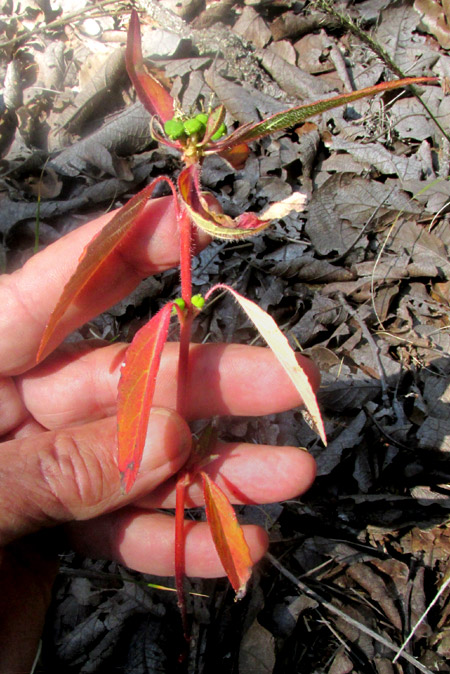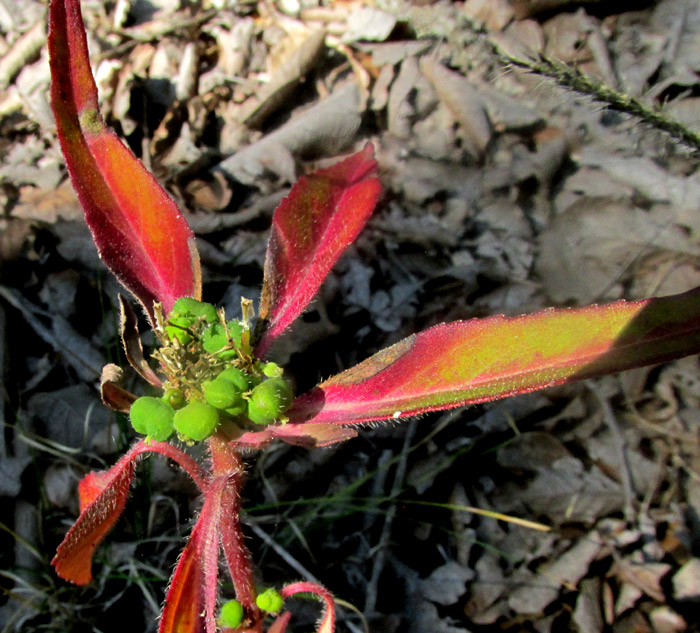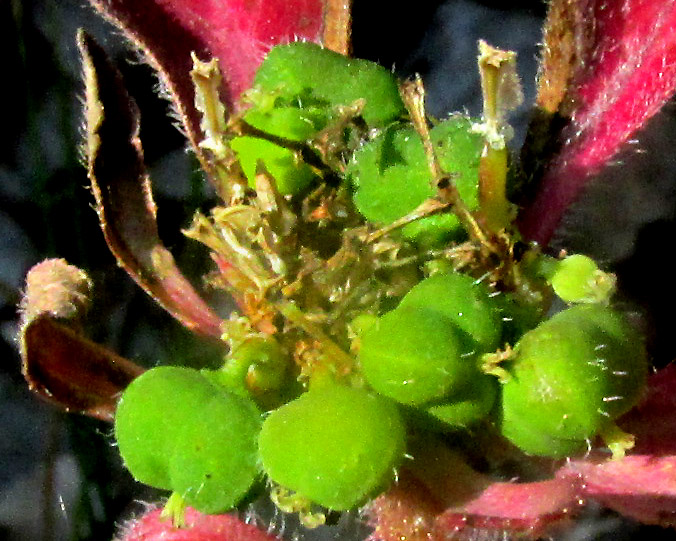Excerpts from Jim Conrad's
Naturalist Newsletter
Entry dated November 7, 2023, from notes taken at Cascadas de La Piedad waterfall 3kms NW of the community of San Pablo, municipality of Almeaco de Bonfil; bedrock of thick layers of compacted volcanic ash, or tuff; N20.1024°, W100.0019°, elevation 2360 meters (7750ft); extreme southern Querétaro state, MÉXICO
TOOTHED SPURGE

On the hillside floor of an oak forest, the above plant stood alone in a narrow beam of shifting sunlight. During a continuing two-year dry period the North American Drought Monitor classifies as a D3 Extreme Drought, and after the current rainy season never developed, the plant was fading, drying and turning red; at this time of year, normally herbs here still are green.

Viewed from above, green fruits are seen clustered amid leaves radiating from the cluster's base. The leaves' margins bear low teeth, and the blades' bases narrow gradually to short petioles. Leaves and stems are hairy.

If the previous picture didn't remind you of Christmas poinsettias, maybe the above closer look at the fruits will. The fruits are schizocarp-type capsules, which will break into three segments. The fruits are three lobed and the styles remaining atop the fruits also are three lobed. Best visible at the picture's lower, left, each fruit arises on a bent stem, the pedicel, at the base of which lies an ambiguous structure. Plant identifiers will recognize here the unique and unmistakable features of spurge flowers, of which poinsettias are one species, in the huge, variable, worldwide genus Euphorbia. Currently Kew's Plants of the World Online database recognizes 2040 accepted species, of which our plant clearly is one. Spurges are members of big Spurge or Euphorbia Family, the Euphorbiaceae.
In our pictures of a past-mature plant, the bizarre structure of Euphorbia flowers is hard to see. The basic spurge-flower structure is more clearly visible on our Grassleaf Spurge page. In the above picture, the slender, brown items looking like gnawed-on apple cores are remnants of already split-open mature fruits.

The above fruits appear at a lower node on our plant. Clearly visible are the fruits' three style-arms, each divided halfway to its base. Note that the fruits and petioles are conspicuously hairy. Later I'd find that for this species some descriptions, including the Flora of North America, describe the fruits as hairless, or glabrous, and on the Internet most pictures portrey hairless fruits. However, other sources dealing with plants of our area, such as the Flora fanerogámica del Valle de México, say that sometimes the fruits are hairy.
The 2002 study by Martha Martínez Gordillo and others entitled "Los géneros de la familia Euphorbiaceae en México," reports 138 Euphorbia species documented for Mexico. The Flora fanerogámica del Valle de México documents for our upland central Mexican region around 24 species. Of those 24 species, if you have an erect Euphorbia producing relatively large fruits 3mm or more long (3/32inch), with long leaves bearing low teeth on their margins, the leaves radiate from immediately below the fruit cluster, and the leaves are present during the flowering period, you have EUPHORBIA DENTATA, the Toothed Spurge.
Toothed Spurges owe their English name to their extensive distribution area, from southern Canada south throughout the US and Mexico into Guatemala, plus another population turns up in Argentina, and the species is invasive in numerous countries. It occurs in a variety of mostly disturbed areas, including dry scrub and grasslands. It's common but, at least in its native area, apparently doesn't become abundant as with many weedy species.
When tissue of most Euphorbia species is cut or broken, a milky sap, or latex, quickly oozes or drips out. This sap is rich in compounds evolved as a deterrent to herbivores, for it has a caustic effect, and may cause a burning sensation. If it enters the eyes, nose or mouth, or sometimes just touches the skin, it can be very painful and cause inflammation.
Sometimes plants bearing toxic compounds are used in traditional medicine, but I find no mention of such use of Toothed Spurge among Mexican communities.